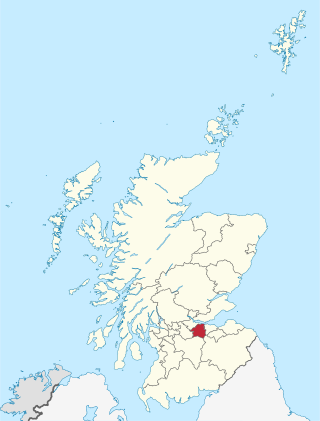
West Lothian is one of the 32 council areas of Scotland, and was one of its historic counties. The county was called Linlithgowshire until 1925. The historic county was bounded geographically by the Avon to the west and the Almond to the east. The modern council area occupies a larger area than the historic county. It was reshaped following local government reforms in 1975: some areas in the west were transferred to Falkirk; some areas in the east were transferred to Edinburgh; and some areas that had formerly been part of Midlothian were added to West Lothian.

John Adrian Louis Hope, 1st Marquess of Linlithgow, 7th Earl of Hopetoun, was a British aristocrat and statesman who served as the first governor-general of Australia, in office from 1901 to 1902. He was previously Governor of Victoria from 1889 to 1895.

Marquess of Linlithgow, in the County of Linlithgow or West Lothian, is a title in the Peerage of the United Kingdom. It was created on 23 October 1902 for John Hope, 7th Earl of Hopetoun. The current holder of the title is Adrian Hope.
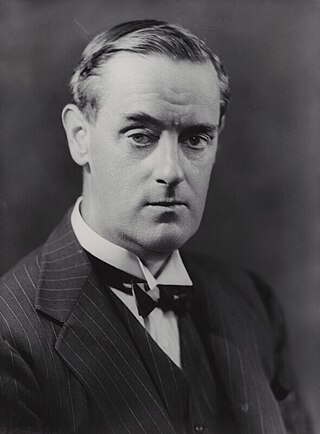
Victor Alexander John Hope, 2nd Marquess of Linlithgow, was a British Unionist politician, agriculturalist, and colonial administrator. He served as Governor-General and Viceroy of India from 1936 to 1943. He was usually referred to simply as Linlithgow.

Charles Hope, 1st Earl of Hopetoun, KT, PC was a Scottish nobleman.
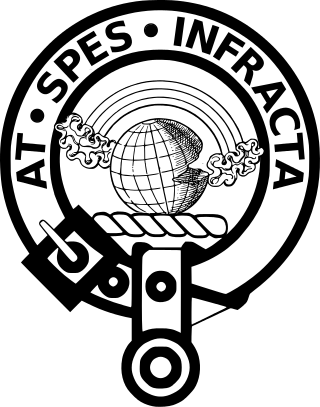
Clan Hope is a Scottish clan of the Scottish Lowlands.

There have been four baronetcies created for persons with the surname Hope, three in the Baronetage of Nova Scotia and one in the Baronetage of the United Kingdom. As of 2010 one creation is extant, one dormant and two extinct.

Kinross House is a late 17th-century country house overlooking Loch Leven, near Kinross in Kinross-shire, Scotland.
Alexander Edward was a priest of the Scottish Episcopal Church who later became a draughtsman, architect and landscape designer. He was a stylistic follower of Sir William Bruce, and planned several gardens in the grand French axial manner.

Dumfries House is a Palladian country house located in the town of Cumnock in East Ayrshire, Scotland. It is within a large estate, around two miles (3 km) west of Cumnock. Noted for being one of the few such houses with much of its original 18th-century furniture still present, including specially commissioned Thomas Chippendale pieces, the house and estate is now owned by The Prince's Foundation, a charity which maintains it as a visitor attraction and hospitality and wedding venue. Both the house and the gardens are listed as significant aspects of Scottish heritage.
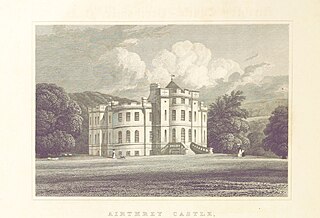
Airthrey Castle is a historic building and estate which now forms part of the buildings and grounds of the University of Stirling in central Scotland. The 18th-century building with 19th-century additions occupies a beautiful setting in landscaped grounds in the southern edge of the Ochil Hills, above the Forth valley. It is located close to Bridge of Allan, two miles from the historic city of Stirling.

Craigiehall is a late-17th-century country house, which until 2015 served as the Headquarters of the British Army in Scotland. It is located close to Cramond, around 9 km (5.6 mi) west of central Edinburgh, Scotland.

Adrian John Charles Hope, 4th Marquess of Linlithgow, styled Viscount Aithrie until 1952 and Earl of Hopetoun between 1952 and 1987, is a British noble. His family seat is Hopetoun House, near Edinburgh, Scotland. He was educated at Eton College.
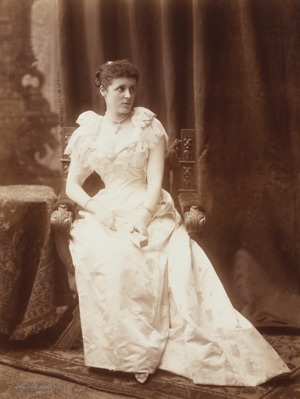
Hersey Alice Hope, Marchioness of Linlithgow was a British aristocrat, who was the wife of John Hope, 1st Marquess of Linlithgow, who, as the 7th Earl of Hopetoun, was the first Governor-General of Australia 1901-1902.

Charles William Frederick Hope, 3rd Marquess of Linlithgow MC was a British peer and businessman.
The Scots Mining Company House, also known as Woodlands Hall, is an early-18th-century mansion house in Leadhills, South Lanarkshire, Scotland. The house was built around 1736 for the manager of the Leadhills mines, which were owned by the Earl of Hopetoun. Its design has been attributed to the architect William Adam.

Estate houses in Scotland or Scottish country houses, are large houses usually on landed estates in Scotland. They were built from the sixteenth century, after defensive castles began to be replaced by more comfortable residences for royalty, nobility and local lairds. The origins of Scottish estate houses are in aristocratic emulation of the extensive building and rebuilding of royal residences, beginning with Linlithgow, under the influence of Renaissance architecture. In the 1560s the unique Scottish style of the Scots baronial emerged, which combined features from medieval castles, tower houses, and peel towers with Renaissance plans, in houses designed primarily for residence rather than defence.

Belgravia is a historical drama, set in the 19th century, based on the 2016 novel of the same name by Julian Fellowes—both named after Belgravia, an affluent district of London. The limited series, a co-production between Carnival Films and American cable network Epix, is adapted by Fellowes from his novel, and reunites the production team behind Downton Abbey with Gareth Neame and Nigel Marchant executive producing alongside Liz Trubridge and Fellowes. Belgravia is directed by John Alexander, and produced by Colin Wratten.
Tobias Bauchop or Baccup was a 17th-century Scottish master mason responsible for several architctural masterpieces, mainly working as contractor to the eminent architect Sir William Bruce.



















